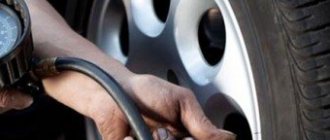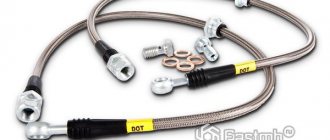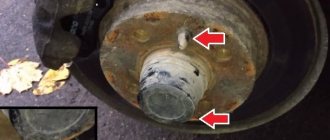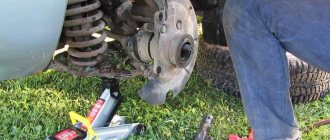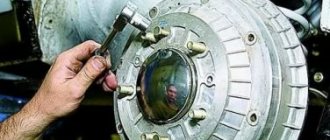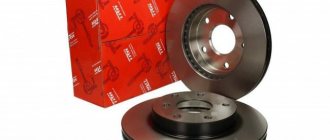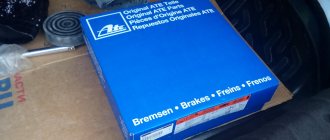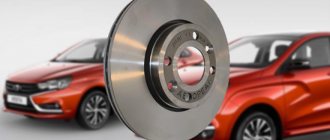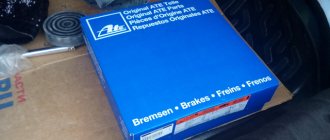Brake discs are an element fixed to the car hub and serve to reduce speed when in contact with the pads due to increasing friction force. The part can be made of cast iron or ceramics: the first type is cheaper, the second is more expensive, but has less weight.
For the Russian car VAZ 2112, mainly ventilated models are produced, which have an effective cooling system and are considered more reliable and durable. The cost of spare parts depends on their type, country of production, type of sale (pieces or sets).
Front drive brakes VAZ
This article will help answer all the questions about switching from one brake to another.
It will also help you figure out what kind of brakes you currently have. To do this, consider the stock front brakes for front-wheel drive VAZ: 2108-21099, 2110-2112, 2113-2115, Kalina, Priora, Granta R13 not ventilated
They were installed on the SAMAR and SAMAR-2 families, as well as on the 10th family (only with an 8-liter carburetor engine).
Explosion diagram Caliper
Visually, they can be distinguished by the lack of ventilation on the brake discs, in addition to the characteristic 2108 boot.
R13 ventilated
They were placed on families 10, Kalin, Grant exclusively with 8kl.
engine. Explosion diagram Caliper
Visually, it is easy to distinguish from 08 by a wider disk with ventilation. Brakes from R14 can be visually distinguished by the brake disc boot ratio.
R14 ventilated
They were installed on families 10, Prior (even with 8kl. ICE), Kalin, Grant with 16kl.
engine. Explosion diagram Caliper
Visually easily determined by the ratio of the brake disc boot. The disc will completely cover the boot. There is another option, remove the fixed bracket and 2112 should be stamped on it. In addition, it is simply impossible to install wheels of 13 radius.
R15 ventilated
They were placed on the Kalin and Grant families from 16kl.
engine in the sport version. Explosion diagram
Standard R13″ ventilated calipers are used (movable caliper 2110, fixed caliper 2110 which is machined to fit a wider brake disc).
And to extend the guide to a larger radius, the plant uses “bone” adapters
When installing them, you need to file the ears on the fist
There is another option that is almost factory-made. Install the Volga calipers using a special spacer. They have their own brake pad, which, in addition to everything, has an even larger area compared to the VAZ one.
RESULT:
1) When moving from R13 non-ventilated to R13 ventilated, you will need: - Caliper bracket 2110 movable 2110-3501017 - Caliper bracket 2110 fixed 2110-3501155 - Brake disc housing right VAZ-2110 (14 inches) 2112-3501146 - Brake disc housing left VA Z -2110 (14 inches) 2112-3501147 — Brake disc VAZ 2110 (13 inches) 2110-3501070 As you can see, we will need brackets, boots and the brake discs themselves. You can leave the old calipers.
2) When moving from R13 non-ventilated to R14 ventilated, you will need: - Caliper bracket 2110 movable 2110-3501017 - Caliper bracket 2112 fixed 2112-3501155 - Brake disc housing right VAZ-2110 (14 inches) 2112-3501146 - Brake disc housing left VA Z -2110 (14 inches) 2112-3501147 — Brake disc VAZ 2112 (14 inches) 2112-3501070 As you can see, we will need brackets, boots and the brake discs themselves. You can leave the old calipers.
3) When switching from R13 ventilated to R14 ventilated, you will need: - Caliper bracket 2112 fixed 2112-3501155 - Brake disc VAZ 2112 (14 inches) 2112-3501070 As you can see, we only need a movable bracket and the brake discs themselves. The calipers can be left as old, the boots were originally designed for R14 brakes, the movable caliper remains the same.
4) When switching to R15 ventilated ones, you will need: - Movable caliper bracket 2110 2110-3501017 (but it needs to be sharpened) - Fixed caliper bracket 2112 2112-3501155 (only if you have R13 not ventilated) - Spacer for the fixed bracket - Disc 15 inch brake
IMPORTANT: after installing R14 brakes, you will definitely have to switch to R14 wheels or a larger radius!
Minimum permissible thickness of brake discs:
For ventilated 17.8 mm For non-ventilated 10.8 mm
Brake pads
For all the brakes described above, there is only one type of pad - 2108. All other differences: (the presence of a wear sensor, friction material,
but not thickness
, its location, various grooves and grooves already depend on the manufacturer).
From personal experience I will say that after switching to R13 ventilated brakes, braking became more effective, squeals when braking almost disappeared. Due to better cooling of the brake disc, its volume and weight increase and heat dissipation becomes faster. When switching to R14, braking becomes even better, especially noticeable at high speeds, due to the increase in the friction surface (the volume and mass of the disc still increases) and the removal of the point from the center of rotation (to put it roughly and simply, the “effect of increasing the shoulder”). If you install a brake disc with perforations and grooves, the braking performance will further increase due to the removal of water and friction material of the brake pad from the contact patch.
Withdrawal procedure
1. Remove the desired wheel and brake pads.
2. Unscrew the 2 bolts securing the shoe guide to the steering knuckle and remove the brake mechanism assembly. At the same time, we do not disconnect it from the wheel cylinder. 3. We hang the removed brake mechanism to the front suspension spring. Do not twist or strain the brake hose.
4. Clean the disk from dirt and apply WD-40 to the connections between the disk and the hub and to the guide pins.
5. Unscrew the 2 guide pins and remove the brake disc. You can knock it down with a rubber mallet. 6. Install the brake disc in the reverse order. If you are replacing an old disk, you need to use a file to remove the beads that have formed during wear.
Stories from our readers
“Fucking basin. "
Hi all! My name is Mikhail, now I’ll tell you a story about how I managed to exchange my two-wheeler for a 2010 Camry. It all started with the fact that I began to be wildly irritated by the breakdowns of the two-wheeler, it seemed like nothing serious was broken, but damn it, there were so many little things that really started to irritate me. This is where the idea arose that it was time to change the car to a foreign car. The choice fell on the melting Camry of the tenth years.
Yes, I had matured morally, but financially I just couldn’t handle it. I’ll say right away that I am against loans and taking a car, especially not a new one, on credit is unreasonable. My salary is 24k a month, so collecting 600-700 thousand is almost impossible for me. I started looking for different ways to make money on the Internet. You can’t imagine how many scams there are, what I haven’t tried: sports betting, network marketing, and even the volcano casino, where I successfully lost about 10 thousand ((The only direction in which it seemed to me that I could make money was currency trading on the stock exchange, they call it Forex. But when I started delving into it, I realized that it was very difficult for me. I continued to dig further and came across binary options. The essence is the same as in Forex, but it’s much easier to understand. I started reading forums, studying trading strategies. I tried it on a demo account, then opened a real account. To be honest, I didn’t manage to start earning money right away, until I understood all the mechanics of options, I lost about 3,000 rubles, but as it turned out, it was a precious experience. Now I earn 5-7 thousand rubles a day. I managed to get the car buy after half a year, but in my opinion this is a good result, and it’s not about the car, my life has changed, I naturally quit my job, I have more free time for myself and my family. You’ll laugh, but I work directly on the phone)) If If you want to change your life like me, then here’s what I advise you to do right now: 1. Register on the site 2. Practice on a Demo account (it’s free). 3. As soon as you get something on the Demo account, top up your REAL ACCOUNT and go to REAL MONEY! I also advise you to download the application to your phone, it’s much more convenient to work from your phone. Download here.
Minimum permissible thickness of brake discs:
- For ventilated 17.8 mm
- For non-ventilated 10.8 mm
Brake discs are distinguished:
- Ventilated discs
- With gas outlets
- With perforation or grooves (slots)
- Collapsible
Brake discs for VAZ 2110
- 120 1 174k
VAZ 2110 is one of the most popular Russian models. The cost of consumables for Russian cars is usually cheap, and you can always save a lot. But there are components on which it is not worth saving; it will cost you more. These components include the brake system.
The basis of the braking system is the brake disc. Disc brakes on the VAZ 2110 are installed only on the front axle, which is where the main force during braking occurs.
Wheels on the VAZ 2110 are divided, depending on the engine, as follows:
- 8 valve VAZ 2110 engines are equipped with R13 brake discs
- 16 valve VAZ 2110 engines are equipped with R14 brake discs
Due to the low cost, many people do not hesitate to install original disks:
- 2108-3501070 — front brake disc r13, not ventilated, cost from 898 rubles.
Today, perhaps, the most unfortunate and unacceptable option. Due to the lack of ventilation, the disc is susceptible to overheating , which means the brake fluid will overheat and boil; this can be clearly felt when the pedal begins to go down. When brake fluid boils, the effectiveness of the brakes drops sharply and you risk being left without brakes at all.
- 2110-3501070 — front ventilated brake disc r13, cost from 3,758 rubles.
An improved version of the previous disc. The main improvement is the appearance of ventilation. The discs do not heat up so much and behave well during quiet driving.
- 2112-3501070 — front ventilated brake disc r14, cost from 919 rubles.
Perhaps the best option among the original discs. Here you have ventilation and an increased contact area with the block. Consequently, you have a lower chance of disc overheating and improved braking properties compared to previous options. Despite their advantages, such discs are not suitable for a driving style with constant brake loads, but remain reliable and comfortable brakes for quiet, everyday driving.
According to the rating of brake discs for the VAZ 2110 on PartReview dated 04/06/20, owners prefer Remsa products. Manufacturers Ashika, Patron and MILES also stand out.
But the choice is not limited to originals. The VAZ 2110 is a popular model and a large number of analogue brake discs are produced for it. So, if you want to save money, you can take BM BD 5222.
- BM BD5222 front brake disc r13, not ventilated, cost from 512 rubles.
- BM BDV221 front ventilated brake disc r13, price from 622 rubles.
- BM BDV220 front ventilated brake disc r14, price from 842 rubles.
BM discs are made in China, and you can't count on improved braking quality. The main advantage of these discs is the price, which in percentage terms is significantly lower than the original discs. But due to the low cost of original disks, the real savings are negligible and it is better to overpay slightly and install original disks.
Thus, there is no point in chasing cheapness, but you can choose an analogue to improve the quality of braking, but here you will have to overpay in comparison with the original ones.
- TRW DF1748 front brake disc r13, not ventilated, cost from 893 rubles.
- TRW DF4108 front ventilated brake disc r13, cost from 920 rubles.
- TRW DF4107 front ventilated brake disc r14, price from 1013 rubles.
Analogs
Below is a table that contains data on the most popular manufacturers of foreign similar spare parts. They are distinguished not only by diameter and price, but also by quality; Almost all of them are sold in sets.
| Brand | Country of Origin | vendor code | About the product | Price |
| Design Service | Russia | 2172-3502000 | An inexpensive set of wheels for the VAZ 2112 modification with ABS, the parts are fully certified, the set includes, in addition to the main products, all consumable components | 21-22 thousand |
| Tornado | Russia | 2108-3502200-12, 2108-3502200-08 | Products with the first article are installed on VAZ 2112 equipped with ABS, and parts with the second number are installed on cars without this system | 15-15 thousand depending on the type of part |
| Lucas | Germany | FR-00000627 | Wheels of size R14, designed for cars with a simple parking brake, are highly reliable, have a long service life, and are fully compatible with a number of AvtoVAZ models | 18-18.5 thousand per set |
Examination of brake discs for VAZ-2110. Disco for "ten"
Approximate price - 1240 rubles.
“Togliatti”, fortunately, did not disgrace itself - only deviations in the beating of the working surface can be called a fly in the ointment, but the balancing is the most accurate. The “water procedures” of the discs also went well and were effective.
I’m leaving the entrance, and in the parking lot my neighbor is warming up his car. And straight to the point: “I changed the brake discs over the weekend - installed ventilated ones!” - boasts. - “Which ones?” —“Ventilated! Previously they were standard, but now they have holes and grooves. Here!" Approximate price - 1600 rubles.
“German” took an intermediate position between good and bad... Before the tests - no complaints, but after the heated disk was lowered into the water, impressive cracks appeared on the metal, and the norm for parallelism turned out to be
The neighbor is mistaken, of course. On front-wheel drive VAZs, ventilated discs are installed initially on the conveyor. After all, the speeds, and therefore the loads on the braking system of modern cars, have increased, and non-ventilated brake discs can no longer cope with the increased temperature of the rubbing surfaces. Here come the brake discs, cast with voids and stiffening ribs that improve cooling. But on standard VAZ parts there are no perforations or grooves - these are, so to speak, additional design features that allow the disks to withstand even greater temperature loads. Like, for example, sports cars.
Since the VAZ 2110 has long become a sports car for many of our compatriots, perforated wheels for these cars also shine with polished metal on the shelves of auto parts stores.
Approximate price - 1450 rubles.
Cons: initially the norm for static imbalance was exceeded three times. After cooling with water, the parallelism and runout standards were exceeded by 2.5 and two times, respectively. Cracks have formed near the perforations
Be an expert! We bought a set of LGR perforated wheels and, of course, couldn’t resist comparing them with the standard ones manufactured in Tolyatti, and also, to complete the picture, with imported German Lucas ones. The tests were carried out, as expected, at NAMI. In addition to the usual parameters - geometric dimensions, static imbalance and hardness of the working surfaces, it was decided to determine the tendency to warp when a heated disk is cooled with water. It happens that in rainy weather, after prolonged braking, willy-nilly you have to swim across a deep puddle. After such a “Camel Trophy”, the steering wheel often shakes when braking - the discs swerved... So when we cooled with water, cracks appeared on the Lucas and LGR discs. The Togliatti fighter did not give up!
As a result of the examination, it turned out that the Togliatti brake disc has deviations in the runout of the working surface, but, oddly enough, the best balancing. The worst for balancing is the perforated disc, which experts say is most likely due to careless drilling of the perforations.
The wear resistance of all types of discs is approximately the same, as well as the wear resistance of the pads themselves when working with domestic and imported discs. But on a perforated disc, pad wear is significantly lower.
The braking efficiency (braking distance) of the domestic disc is slightly better than that of the others, but the perforated ones have an advantage when working in high-temperature zones. So, on the 25th braking, the temperature for non-perforated discs rose to 350–360°C, for perforated discs - to 280°C.
In the end, everything is like with people: each brake disc has its own advantages and disadvantages. But let’s answer the main question of the examination: is it worth installing perforated disks on the “ten”? Experts believe that perforation in the inherent range of temperatures, pressures and speeds of the VAZ 2110 not only does not provide significant advantages, but also worsens a number of characteristics, while increasing the cost of the product. Is it worth bragging?
Where can I see the VIN code?
It's not difficult to do.
The code can be found:
- on a plate installed on the central pillar in the lower part near the driver's car seat;
- under the hood;
- on the threshold of a car;
- on the windshield;
- under the spare tire;
- in vehicle documents.
Once the code is detected it can be read. How to do it?
Brake discs for VAZ 2110
It's no secret that the domestic VAZ 2110 car is one of the most famous Russian brands. Consumables for domestic vehicles are, as usual, inexpensive and you will thus have a good opportunity to save a certain amount. However, there are also such nodes where you just need to fork out so that you don’t end up paying more in the future. These include the braking system.
- VAZ 2110 eight-valve engines are formed by R13 brake discs
- sixteen-valve VAZ 2110 engines - R14 brake discs
It is impossible to install R14 brake discs on machine wheels of thirteenth radius.
The minimum thickness of brake discs should be: for ventilated ones - 17.8 millimeters; for non-ventilated ones - 10.8 millimeters.
Considering the low price, most car owners are happy to install original wheels:
- 2108-3501070 — brake disc (TD) r13 front non-ventilated (NV), price — from eight hundred and ninety-eight rubles.
In the modern world, one might say, the most unfavorable and inappropriate method. Since there is no ventilation, the disc may well overheat, and this, in turn, means that the brake fluid will overheat and boil, you will immediately understand this - the pedal begins to go down. When this liquid boils, the effectiveness of the brakes immediately decreases and a situation may arise where you are simply left without brakes.
- 2110-3501070 — TD r13 front ventilated (PV), its price will be from three thousand seven hundred and fifty-eight rubles.
This option, to be honest, is, of course, better than the previous disc. Its main advantage is that ventilation appears. The discs do not get very hot and behave well during quiet driving.
- 2112-3501070 - TD r14 PV, price - from nine hundred nineteen rubles.
This, hand on heart, is the most successful version of the original discs. There is both ventilation and an increased contact area with the block. It follows from this that you will have a lower probability of disc overheating and better braking properties compared to the above options. If you do not take into account the listed significant advantages, then such discs do not fully correspond to a driving style with constant loads on the brakes, but remain reliable and comfortable brakes for everyday driving.
There are many others. VAZ 2110 is the most famous brand and many analogues of brake discs are produced for it. If you want to spend a little, then feel free to take the BM BD 5222.
- BM BD5222 TD r13 Night vision, price - from five hundred twelve rubles.
- BM BDV221 TD r13 PV, price - from six hundred twenty-two rubles.
- BM BDV220 TD r14 PV, price - from eight hundred forty-two rubles.
The country of origin of the discs is China, and at the same time, one should not hope for good braking quality. The main advantage of these discs is their cost, which in percentage terms is much lower than the original ones. But due to the low price of original disks, the real savings are very small and it would be better to buy more expensive ones and install original ones. A famous saying goes: “The miser pays twice.
Let's summarize. There is no point in buying cheap ones, but choosing an analogue for better braking quality is not only possible, but necessary, but you need to pay extra compared to the original ones.
- TRW DF1748 TD r13 NV, price - from eight hundred and ninety-three rubles. TRW DF4108 TD r13 PV, price - from nine hundred and twenty rubles.
- TRW DF4107 TD r14 PV, price - from one thousand thirteen rubles.
TRW is a good option. The brakes can be compared to the originals, and behave better in extreme situations. The discs withstand overheating , cool faster and provide better braking.
- Brembo 08.5211.10 TD r13 NV, price - from seven hundred eighty-four rubles.
- Brembo 09.8894.14 TD r13 PV, price - from one thousand one hundred rubles.
- Brembo 09.8903.14 TD r14 PV, price - from one thousand sixty-three rubles.
Most car owners choose Brembo for its sporting history. Brembo discs are a truly high-quality product, although they are far from sports developments. But the VAZ is not a sports car, so Brembo wheels meet the requirements of the car in all respects . Brembos are excellent at withstanding overheating and provide better braking in various situations.
- Ate 24.0112-0125.1 TD r13 NV, price - from nine hundred and ninety rubles. Ate 24.0120-0186.1 TD r13 PV, price - from one thousand five hundred and ninety rubles. Ate 24.0120-0187.1 TD r14 PV, price - from one thousand five hundred ninety-six rubles.
Ate is more expensive than original discs. But there is something to pay for here: high quality, comfortable braking in various situations, resistant to overheating and deformation. And most importantly, everyone who wanted to install them is happy with both the new brakes and their service life.
The cost is indicated for Moscow and the region as of winter 2016.
pros
Let's look at why disc brakes are better than drum brakes:
Braking becomes more reliable, braking distance is reduced; Braking forces are distributed more evenly, given that the VAZ 2110 is a front-wheel drive car; There is an effect of faster response after pressing the pedal; Unsprung masses are reduced; Heat dissipation occurs better, which is especially important when driving on a mountain road or during active acceleration/braking. For this reason, the brake system is cooled better; Disk ones are much easier to dismantle and replace; There is no need to adjust the handbrake after each repair of the rear brakes, although this will have to be done the first time; They do not freeze in winter after washing, like drum ones; Rear disc brakes installed on the VAZ 2110 are much more convenient to control and timely notice pad wear
Replacement steps
The entire replacement process can be divided into several stages:
- Removing wheels;
- Removing the old brake pad;
- Frame disassembly;
- Cleaning the hub and checking it;
- Removing coating from new disks;
- Runout check;
- Installation of new brake system elements.
Now let's talk about this in more detail.
Removing the wheel
In fact, dismantling the wheel for subsequent replacement of the brake elements is not difficult.
But a certain sequence of actions will have to be followed.
- Place a jack under the car.
- Lift it up so that it doesn't tip over, but still allows you to easily remove the wheels.
- Unscrew the wheel fasteners.
- Remove the hubcaps and the wheels themselves.
As you can see, the procedure is really simple, but it requires attention and accuracy.
Removing the pads
- Try to move the piston as far as possible from the brake mechanism. But do not exceed the distance beyond that which will allow you to comfortably remove the brake pads.
- Take out the block.
- To make the job easier, you can disassemble the brake frame. To do this, unscrew the two bolts securing the block and disconnect the device.
Hub
It must be cleaned, since all accumulated debris, dirt, and rust will negatively affect the effectiveness of the new brakes.
Dirty
For cleaning, alcohol-based solvents and metal brushes are used. If cleaning is not performed, the operation of the brakes will be accompanied by beating - this should absolutely not be allowed.
Be sure to check the hub for runout. Normally it does not exceed 0.1 mm. There is a special tool for checking. If the indicator is within normal limits, then a full assembly is performed.
Working with new disks
Many owners of the “Ten” are interested in which brake discs are best to choose for the VAZ 2110. The question is quite logical.
Choose certified replacements from reputable manufacturers such as Bosch, or stay true to factory parts. These are the two best options in terms of quality and compliance with the car itself.
New
Some take similar discs that partially fit the “ten”, sharpen them, and adjust the design. This is a dubious undertaking, since it requires serious skills in such a matter, additional time and financial costs. At the same time, it is far from a fact that such brakes will work better than those offered by the AvtoVAZ plant.
You've already figured out how to remove the brake element, so it's time to work on a new one. It’s not enough to just buy another brake disc and put it in place. First, it is prepared and a runout check is performed. Let's talk about this in more detail.
- The coating must be removed from a new disc.
- This coating serves as a kind of preservative.
- The layer is removed using any solvent.
- Clean thoroughly and wipe the part dry after finishing work.
- Now you can put the disk in a new place and check the runout.
- The permissible runout is no more than 0.15 millimeters.
- If the value is exceeded, this can lead to an increase in the sensitivity of the brake pedal, as well as the formation of vibrations during braking.
Installation and testing
Before changing brake discs, make sure that the problem with the brake system lies precisely in them. There are a number of other problems that are typical for the “ten” and all cars in general. A full diagnostic will be required so that the replacement is not in vain.
Adjustment
In fact, installation is performed in the reverse order of disassembling the brake discs. Therefore, there should not be any special problems.
But checking functionality is a more important and, to a certain extent, complex issue.
The first thing that experts advise is a full running-in of new discs. To do this, you need to travel about 500 kilometers. In this case, you need to brake smoothly, without making sudden impacts on the brake pedal. If this is not done, defects may form on the disks, and the cause will be simple overheating.
Let's get started
Pumping is carried out in a certain sequence. The diagram is criss-cross. First, the air is pumped out of the rear right wheel. Then - from the front left. Next they move to the rear left and then to the front right disc. So, we tear off the bolts from the desired wheel, put the car on a jack and install the stops. It is impossible to lift on clamped blocks. Next, open the hood and add fluid to the maximum. We will need an assistant who will press the pedal several times on command.
Today, for no apparent reason, when I pressed the brake pedal, it sank almost to the floor. The brake grabs, but weakly. When the pedal is near the floor, only then does the car slow down. I barely made it to the garage. It is not a happy prospect to be the victim of an accident. Tell me what could be the reason. How to fix?
The reasons for the failure of the brake pedal can be: Very often the simplest thing is a decrease in the quality of the brake fluid. The liquid is hygroscopic and absorbs moisture; it may be time to foam the liquid and also check its level. It may also be that the main brake cylinder (GTC) has failed. After replacing brake discs or pads, such troubles sometimes occur. Incorrectly adjusted gap between the GTZ piston and the pedal in the car. Sometimes the pedals and their rods are rusty. Vacuum pump, etc. is faulty. The main thing is not to panic, but to identify and eliminate the reason why the pedal fails.
I would first check the brake fluid level, then bleed the brakes. If that doesn't help, then look at the brake master cylinder.
Perhaps air has entered the system; this may be due to wear on the brake pads, drums, or discs. We need to check everything and take action. Brakes are no joke. It is best to contact the service.
Ten years ago, due to inexperience, I poured low-quality brake fluid into the system. As a result, the brake hoses swelled and separated from the inside. This also rendered the cuffs in the GTZ unusable. And similarly, I had problems with the brake pedal. Air got into the system and everything had to be changed. Maybe you have the same problem.
Correctly adjust the gap between the pedal and the piston. If the gap is large, the pedal rod does not reach the GTZ piston and the pedal fails. And on the other hand, with a small gap, the brake fluid does not allow the pedal to reach the end. Both the current and the other are not correct and lead to problems with the brakes.
If you recently changed your brake pads, this may well be the case. The pedal initially fails during break-in. Top up the brake fluid and bleed the brakes again. When bleeding, place a 3-4 cm block under the brake pedal so that the pedal does not rest on the floor and everything will be OK.
After replacing the brake discs, when braking, I felt as if the brake pedal was sinking and hitting my foot. I went to a mechanic who changed the brake discs. He reassured me and said that after running for about 400-500 km everything would work out on its own. And so it happened, everything gradually returned to normal and now everything is OK.
If the brake pedal sinks all the way to the floor, or only engages every once in a while, or does not return to its place, and the brake fluid and spring are fine, then there is no option but the problem is in the master cylinder. It is better to replace the GTZ with a new one. After replacing the brake cylinder, it is better to completely replace the brake fluid.
The brake pedal falls off. Why? The reason may be cracks in the hoses or a broken vacuum pump. As a result, air gets into the brake system. As a result, the brakes do not work well, you need to bleed the brakes, but it is best to contact a specialist. Brakes are no joke.
Without apparent reasons and proper maintenance, brake failure is very rare. If the brake pedal on your car has stuck (fallen) to the mat, you need to press it all the way. Modern cars have a dual-circuit braking system. Maybe one of them has failed, and the brakes are worse, and the brake pedal goes to the floor. If there is no result, quickly release and press the pedal 5-6 times, the pressure in the system should be restored and you will be able to stop the car.
The serviceability of the braking system on any car is, for obvious reasons, of paramount importance, since overall driving safety directly depends on the effectiveness of the brakes. Taking into account the above, any deviations from the norm (even minor ones) in the operation of this unit are a reason to immediately identify the cause of the malfunction. In this article we will talk about what to do if the brake pedal fails while the engine is running, problems arose after replacing the brake fluid, bleeding the brakes or other elements of the brake system, etc.
Read in this article
Signs you need to replace drives
Not all car owners pay attention to the condition of their brake discs, which is why the problem of their failure occurs at the most inopportune moment. We recommend learning from the mistakes of others rather than making your own.
To determine whether the condition of the brake discs is close to the need to replace, it is recommended to do the following:
- Check the thickness of the brake disc. The normal size is 17 millimeters. This is when we are talking about ventilated discs;
- Non-ventilated elements have their own indicator, and it is 10 millimeters;
- Check runout. This parameter is normally 0.15 millimeters and does not exceed it;
- Runout indicators should be measured at professional service stations that are equipped with appropriate equipment. Independent measurements do not always give accurate results;
- Examine the surface of the brake disc. If you find any damage, defects, chips, or cracks, be sure to replace parts immediately;
- As for choosing new items, purchase them exclusively from certified stores that have permission to provide the appropriate services. Buying on the market can lead to fakes that do not meet strict safety standards. Alas, there are now more than enough such discs;
- You should buy ventilated discs, the shelf life of which is significantly longer than their non-ventilated counterparts, plus their efficiency is better. The air flow that cools the brakes approximately doubles the lifespan of a simple non-ventilated brake system.
The process is complex, but possible to do it yourself. Follow instructions, observe safety regulations, and use only high-quality, proven parts. Still, reliable brakes are a guarantee of your safety and the safety of all other road users.
Absolutely do not do this!
Some home-grown “Kulibins”, trying to save money on buying new brake discs, perform sometimes mind-boggling procedures in order to compensate for the minimum thickness of the brake discs.
For example, two brake pads are installed. To prevent the brake cylinder pistons from falling out. This ultimately leads to the fact that at speed the brake pads simply fly off to... nowhere. At the same time, the path of the car is known - into a ditch, and it’s good if there are no casualties.
Replacing worn brake discs at the wrong time can also lead to failure of the pistons of the working brake cylinders, CV joints, ball joints, etc. That is, by trying to save money and procrastinate, you can then lose more money. Remember the stingy...
Monitor the condition and thickness of the brake discs, and take measures to eliminate any defects noticed - there is too much at stake to neglect this.
Good luck determining the thickness of your brake rotors and replacing them.
